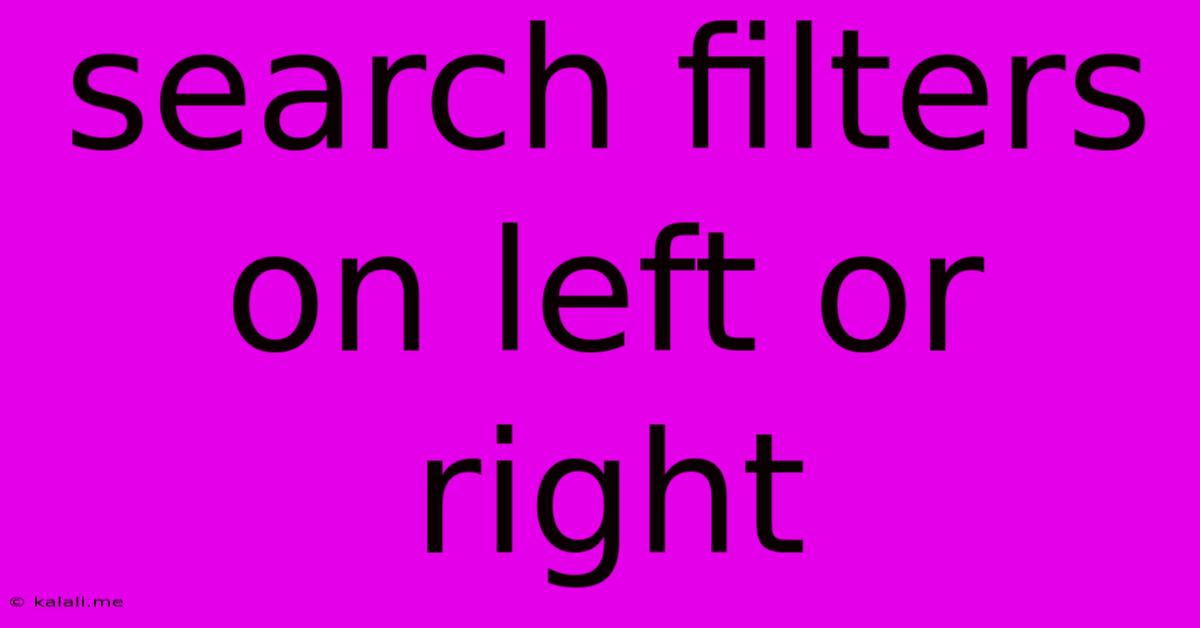Search Filters On Left Or Right
Kalali
May 23, 2025 · 4 min read

Table of Contents
Search Filters: Left or Right Sidebar – The Ultimate UX Showdown
Choosing the placement of search filters—left or right sidebar—is a crucial design decision that significantly impacts user experience and conversion rates. This article dives deep into the pros and cons of each approach, offering insights to help you make the best choice for your website. Understanding user behavior and the nuances of web design will be key to optimizing your search functionality.
Meta Description: Discover the best placement for search filters on your website – left or right sidebar? We analyze UX, conversion rates, and user behavior to help you make the optimal choice for your platform. Learn about the advantages and disadvantages of each position, plus best practices for filter design.
Why Filter Placement Matters
Search filters are essential for users navigating e-commerce sites, job boards, or any platform with extensive searchable data. Poorly placed filters lead to frustration, decreased engagement, and ultimately, lost sales or conversions. The placement directly influences the user's workflow and their ability to quickly refine search results. Therefore, choosing the right location isn't merely an aesthetic consideration; it's a strategic design decision that impacts your bottom line.
Left Sidebar Filters: A Classic Approach
The left sidebar has long been a popular location for search filters. This placement leverages established user expectations and offers some distinct advantages:
- Familiar User Experience: Many users are accustomed to seeing filters in the left sidebar, creating a sense of familiarity and ease of navigation. This reduces the learning curve and allows users to quickly find and utilize the filtering options.
- Improved Visual Hierarchy: A left sidebar neatly organizes filters, creating a clear visual separation between filtering options and search results. This structure improves scannability and allows users to quickly assess available filter options.
- Consistent with Established Design Patterns: Adhering to established design patterns can positively impact user experience and reduces cognitive load. The left sidebar for filters is a well-established pattern in many web applications.
However, the left sidebar isn't without its drawbacks:
- Screen Real Estate: On smaller screens, a left sidebar can consume valuable screen real estate, reducing the visible search results area. This can be particularly problematic on mobile devices.
- Potential for Overwhelm: If you have a large number of filter options, a left sidebar might feel cluttered and overwhelming for users. Careful categorization and organization are crucial to mitigate this.
Right Sidebar Filters: An Alternative Strategy
Placing filters in the right sidebar is a less conventional approach, but it offers unique benefits:
- Maintains Focus on Results: Keeping the primary search results in a prominent location allows users to immediately see the impact of their filter selections. This improves the overall user flow and satisfaction.
- Responsive Design Flexibility: On smaller screens, a right sidebar can be easily collapsed or hidden, maximizing the available space for search results. This addresses the screen real estate limitations often associated with left-sidebars.
- Potential for Contextual Information: The right sidebar can also incorporate supplementary information, such as product recommendations or related searches, further enriching the user experience.
However, this approach also presents challenges:
- Unfamiliar Layout: Users might find a right sidebar filter placement unfamiliar and less intuitive, leading to a steeper learning curve.
- Limited Screen Space: The right sidebar might still be limited in space, especially when dealing with extensive filter options. This could necessitate clever design techniques to handle many filters effectively.
Best Practices for Filter Placement, Regardless of Position
Irrespective of your chosen placement (left or right), consider these best practices for optimal user experience:
- Clear and Concise Labels: Use clear, concise, and easily understandable labels for all filter options.
- Logical Grouping and Categorization: Group related filters logically to improve scannability and usability.
- Visual Cues and Feedback: Provide clear visual cues to indicate which filters are active and their impact on the search results.
- Progressive Disclosure: Consider using progressive disclosure techniques to hide less frequently used filters or to reveal advanced options only when needed.
- Mobile Responsiveness: Ensure your filter design is responsive and adapts seamlessly to various screen sizes.
- A/B Testing: Conduct A/B testing to compare the effectiveness of different filter placements and configurations on your specific website.
Conclusion: The Verdict
The "best" placement for search filters – left or right – depends heavily on your specific website design, user base, and the complexity of your filtering options. Careful consideration of user experience, responsive design, and A/B testing are crucial to make an informed decision. By analyzing the pros and cons of each approach and implementing best practices, you can create a highly effective and user-friendly search experience that boosts conversions and overall satisfaction.
Latest Posts
Latest Posts
-
Wil Latex Primer Last On Pressure Treated Plywood
May 23, 2025
-
How To Get To Kala E Bay
May 23, 2025
-
Ac Unit Blowing Cool Air Outside
May 23, 2025
-
Why Do Some Edges Have Light Blue Lines Blender
May 23, 2025
-
We Want To Assign 1 To The Output One
May 23, 2025
Related Post
Thank you for visiting our website which covers about Search Filters On Left Or Right . We hope the information provided has been useful to you. Feel free to contact us if you have any questions or need further assistance. See you next time and don't miss to bookmark.